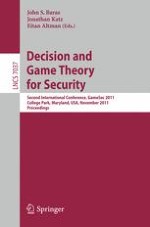2011 | Buch
Decision and Game Theory for Security
Second International Conference, GameSec 2011, College Park, MD, Maryland, USA, November 14-15, 2011. Proceedings
herausgegeben von: John S. Baras, Jonathan Katz, Eitan Altman
Verlag: Springer Berlin Heidelberg
Buchreihe : Lecture Notes in Computer Science
